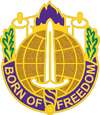United States Army Civil Affairs and Psychological Operations Command
| United States Army Civil Affairs and Psychological Operations Command (Airborne) | |
|---|---|
 U.S. Army Civil Affairs & Psychological Operations Command (Airborne) shoulder sleeve insignia. | |
| Active | 1990–present |
| Country |
|
| Branch |
|
| Type |
|
| Role |
|
| Garrison/HQ | Fort Bragg, North Carolina |
| Commanders | |
| Current commander | MG Daniel R. Ammerman |
| Insignia | |
| Distinctive unit insignia of the command |
 |
| Unit flash of the command |
 |
| Combat service identification badge |
 |
The United States Army Civil Affairs and Psychological Operations Command (Airborne), or USACAPOC(A), was founded in 1985. USACAPOC(A) is composed mostly of U.S. Army Reserve soldiers in units throughout the United States. Its total size is approximately 10,000 soldiers, making up about 94 percent of the DoD's Civil Affairs forces and 71 percent of the DoD's Psychological Operations forces. It is headquartered at Fort Bragg, NC.[1] The current commander (2014) is Major General Daniel R. Ammerman, who assumed command in June 2014.
Historically, USACAPOC(A) was one of four major subordinate commands comprising the U.S. Army Special Operations Command. In May 2006, the reserve component of USACAPOC(A) was transferred to the U.S. Army Reserve Command. The Army's active duty Special Operations Civil Affairs and Psychological Operations units, along with the Civil Affairs and Psychological Operations Force Modernization/Branch Proponents, continue to fall under the U.S. Army Special Operations Command and its subordinate United States Army John F. Kennedy Special Warfare Center and School respectively. The active component special operations civil affairs brigade 95th Civil Affairs Brigade falls under United States Army Special Operations Command (USASOC).[2]
Army Reserve Civil Affairs and Psychological Operations make up five percent of the U.S. Army Reserve force, but account for about 20 percent of Army Reserve deployments. The command's soldiers bring civilian expertise not found among regular active duty soldiers. The projects they coordinate are the subject of many of the "Good News" stories run in the American media each day about Iraq, Afghanistan and the Horn of Africa.
Information Operations
The Information Operations (IO) mission is to synchronize related capabilities in electronic warfare, psychological operations, operations security, and network operations with the overarching objective of gaining, maintaining and controlling the information environment on the battlefield.[3] Two Theater IO groups, the 151st and 152nd, were realigned under the command of USACAPOC(A) in October 2015.[4][5]
| Unit | Distinctive unit insignia | Commander | Headquarters | Subordinate Units |
|---|---|---|---|---|
| 151st Theater Information Operations Group |  |
COL Curtis Carney[4] | Queens, New York | |
| 152nd Theater Information Operations Group |  |
Civil Affairs
The primary mission of Civil Affairs is to conduct civil-military operations. Civil Affairs soldiers are responsible for executing five core CA tasks, Civil Information Management, Foreign Humanitarian Assistance, Nation Assistance, Population and Resource Control, and Support to Civil Administration. Some sub tasks to these core tasks include identifying non-governmental and international organizations operating in the battlespace, handling refugees, civilians on the battlefield, and determining protected targets such as schools, churches/temples/mosques, hospitals, etc.
Civil Affairs units are the field commander's link to the civil authorities in that commander's area of operations. The soldiers make up teams which interface and provide expertise to the host nation government. USACAPOC(A)'s Civil Affairs soldiers are particularly suited for this mission since they are Army Reserve soldiers with civilian occupations such as law enforcement, engineering, medicine, law, banking, public administration, etc.
Civil Affairs soldiers have been integral to U.S. peacekeeping operations in Iraq, Afghanistan, the Horn of Africa, Bosnia and Kosovo, among others. Tactical Civil Affairs teams go out and meet with local officials, conduct assessments and determine the need for critical infrastructure projects such as roads, schools, power plants, clinics, sewer lines, etc., and check up on the status of the project after construction by a local company has begun.
| Unit | Distinctive unit insignia | Commander | Headquarters | Subordinate Units |
|---|---|---|---|---|
| 350th Civil Affairs Command |  |
BG Jeffrey C. Coggin | Pensacola, Florida | The 350th CACOM is the only CACOM HQ that is both a Brigade and a CACOM HQ.
|
| 351st Civil Affairs Command |  |
BG Christopher W. Stockel | Mountain View, CA |
|
| 352nd Civil Affairs Command |  |
BG Jeffrey W. Jurasek | Fort Meade, MD |
|
| 353rd Civil Affairs Command |  |
BG Glenn Goddard | Ft. Wadsworth, Staten Island, NY |
|
Psychological Operations

Psychological operations are a vital part of the broad range of U.S. political, military, economic and ideological activities used by the U.S. government to secure national objectives. PSYOP is the dissemination of information to foreign audiences in support of U.S. policy and national objectives.
Used during peacetime, contingencies and declared war, these activities are not forms of force, but are force multipliers that use nonviolent means in often violent environments. Persuading rather than compelling physically, they rely on logic, fear, desire, or other mental factors to promote specific emotions, attitudes, or behaviors. The ultimate objective of U.S. military psychological operations is to convince enemy, neutral, and friendly nations and forces to take action favorable to the U.S. and its allies.
Psychological operations support national security objectives at the tactical, operational and strategic levels of operations. Strategic psychological operations advance broad or long-term objectives. Global in nature, they may be directed toward large audiences or at key communicators.
Operational psychological operations are conducted on a smaller scale. They are employed by theater commanders to target groups within the theater of operations. Their purpose can range from gaining support for U.S. operations to preparing the battlefield for combat.
Tactical psychological operations are more limited, used by commanders to secure immediate and near-term goals. In this environment, these force-enhancing activities serve as a means to lower the morale and efficiency of enemy forces.
Both tactical and theater-level psychological operations may be used to enhance peacetime military activities of conventional forces operating in foreign countries. Cultural awareness packages attune U.S. forces before departing overseas. In theater, media programs publicize the positive aspects of combined military exercises and deployments.
In addition to supporting commanders, PSYOP units provide interagency support to other U.S. government agencies. In operations ranging from humanitarian assistance to drug interdiction, psychological operations enhance the impact of those agencies' actions. Their activities can be used to spread information about ongoing programs and to gain support from the local populace.
Psychological operations units in the U.S. Army Reserve are language and culturally oriented. Seventy one percent of the Department of Defense's PSYOP capability rests within USACAPOC (A)'s 2nd and 7th Psychological Operations Groups located in Ohio and California respectively.
| Unit | Distinctive unit insignia | Commander | Headquarters | Subordinate Units |
|---|---|---|---|---|
| 2nd Psychological Operations Group |  |
Colonel Jesse Manning | Twinsburg, Ohio |
|
| 7th Psychological Operations Group |  |
Colonel Randall Cartmill | Mountain View, California |
|
1st Training Brigade
The 1st Training Brigade (Civil Affairs/Psychological Operations - CAPO) trains the command's troops.[6]
| Unit | Distinctive unit insignia | Commander | Headquarters | Subordinate Units |
|---|---|---|---|---|
| 1st Training Brigade (CAPO) | Fort Bragg, North Carolina |
|
References
- ↑ Pike, John. "Army Civil Affairs and Psychological Operations Command (Airborne)". GlobalSecurity.org. Retrieved 2016-04-21.
- ↑ "Our Commands: U.S. Army Reserve Command: About Us". U.S. Army Reserve. Retrieved 2016-04-21.
- ↑ 151st Theater Information Operations Group, usar.army.mil, last accessed 26 March 2017
- 1 2 151st TIOG changed leadership during ceremony, army.mil, by MSG Mark Bell, dated 21 August 2015, last accessed 26 March 2017
- ↑ U.S. Army Civil Affairs & Psychological Operations Command (Airborne), usar.army.mil, last accessed 26 March 2017
- ↑ http://www.usar.army.mil/Commands/Functional/USACAPOC/USACAPOC-Units/